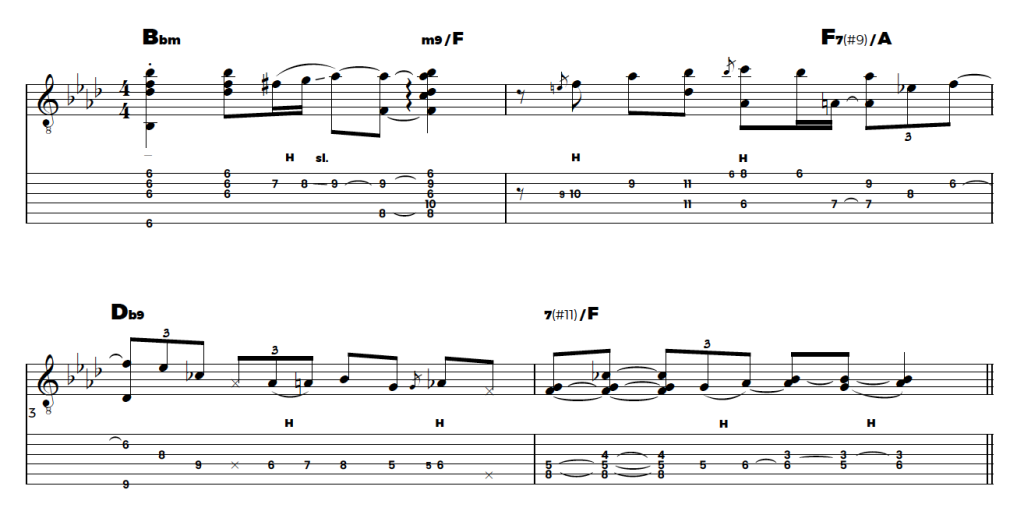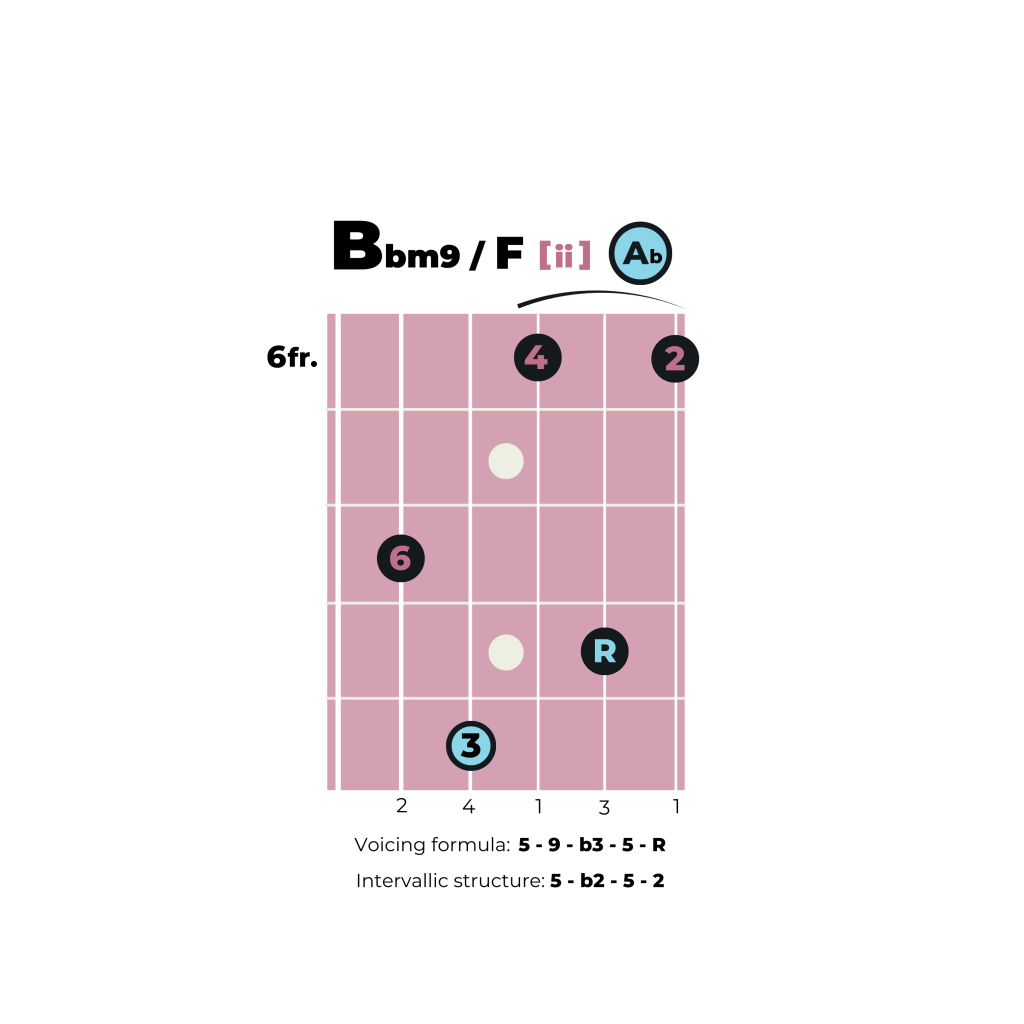Charles Mingus compositions are distinct in how they tend to evoke a wide range of emotions, contrasting the subtle, complex, and intricate with more direct, raw, yet still very sophisticated musical expressions. This becomes evident, listening to the version of Fables of Faubus from his album Mingus Ah Um, even more so with other documented live renditions, e.g. Mingus in Europe Volume 1, Original Faubus Fables.
The way that he used to sculpt and intertwine harmonies, melodies, and rhythms with his fellow musicians into musical masterpieces suggests a gradual approach in order to learn more about the deep qualities of his work and how to appreciate and translate these towards one’s own musical offerings.
A closer look at only a couple of bars of one of his compositions or performances already opens up a number of routes that can be explored.
Mingus on guitar?
He performed with guitarist like Tal Farlow as a sideman, e.g. with the Red Norvo trio. Check out their take on September Song for a sample of his rhythm playing or Farlow’s double-time lines.
The focus with his own ensembles and compositions was more often on instruments like saxophones or the piano – that amounts to a welcome challenge to arrange and perform his music for and on guitar, adding its distinct tonal qualities in a creative way while staying true to the originally composed sound textures.
The idea for the etude at hand is to harmonize melodies with simple sonorities, e.g. standard 4-part voicings, also double-stops which allow to add contrary motion. The occasional, more colorful chord voicing, and the included counter melodies, inspired by the original head arrangements already provide for the needed harmonic and rhythmic information to provide context for the listener.
The melody
It’s always advisable to familiarize oneself with the melody first. In fact, the first task is to understand which notes actually constitute the melody. E.g. the last note in the first bar might ring beautifully as a top note of the voicing but it only supports the first motif rhythmically and harmonically, being part of a chord grip.

The melody is based on the minor pentatonic [ F minor pentatonic in the key of Ab major ] with added chromatic passing notes – similar to Mingus’ most well-known composition Goodbye Pork Pie Hat. Note that an ‘additional’ pitch like Db [ b6 in relation to F aka ‘Aeolian 6’ ] only occurs in bar 10 as part of a phrase, leading to another section of the composition.
The first 8 bars can be roughly divided into a melodic call-and-response idea [bars 1-2 / 5-6] which is then followed by two short, rhythmic riff variations [bars 3-4 / 7-8].
An open invitation to loop these sections individually, to work some on technical prowess while exploring the structure of the melody.
The contrasting idea for the arrangement is to outline the harmony with a standard 4-part voicing [Bbm], followed by a richer-sounding 5-part voicing [Bbm9/F] – more on that one in a moment -before thinning textures out again: one added note to a melody at a time often does the trick.
The borrowed ‘out of key’ note A [b9 in the key of Ab] in bar 2 is a good example. Besides adding harmonic information it also provides for a stronger resolution tendency towards the next harmony.
The same applies to the counter melody in bar 7, functionally [Ab7b9 to Db13]. It also encircles a target note of the next chord while the melody ascends, thus creating contrary motion. An easy way to create similar effects is to find harmonic target notes that 1. define a harmony and 2. create an ‘interesting’ sonority.
In this case the target note is the b7 of Db13 (the 3rd would be the next practical option – in fact, it could be added as part of a complete voicing) and the resulting interval with the ascending melody a 7th, a stronger statement as compared to the more consonant voicing before.
Find a similar approach in bars 9 to 12, only in reverse. Single accompanying, lower notes come before more complete chord voicings.
Harmonic functions!
Now, back to that Bbm9/F voicing. It likely amounts to a good example how to benefit from knowing the close relationship / interchangeability of scale degrees, especially regarding their functions.

Play the first bar, stop on beat 4 and let the chord ring out – how does it sound to your ear? Resolved or suspended? Or rather like a dominant chord, about to resolve?
The harmony sports added notes from the tonic [3 in the key of Ab / 9th of the chord] but having all the other ‘subdominant’ notes [2,4,6] creates a ii chord in context. The voicing itself is a common inversion of a standard Db∆, the related IV chord, with an added Bb on top via the high e-string.
That is obviously the root of Bbm, steering the aural impression more towards the minor chord than, say, making one’s mind compute something like “Db∆add6/F” 😉
Knowing these relationships in a key helps to find more voicing options more easily. Extra speed for arranging and improvising.
In this case, all known voicings of Db [IV] and their variations can be considered a ‘substitute’ or option for a given “standard” ii chord voicing [Bbm] e.g. like the one on beat 1: to add color or contrast to a harmonization, and to hear and ‘see’ more possible spots on the fretboard where to actually find these.
The color coding of the diagram also shows how a given choice of notes works out to create a more tonic, subdominant or dominant sound function in context. The ‘subdominant notes’ 2 – 4 – 6 are the plain ii minor chord. Add the root note Ab [R] of the key: this creates more tension = Bbm7. Add yet another ‘tonic note’ C [3]: Bbm7/9

The following harmony is actually the IV chord, again the related subdominant function. No real movement here – but wait, really?
Almost – it’s a subdominant function Db9 with a b7 [IV7] instead of the diatonic Db∆. Again, only one note is changed, the diatonic C [3] is lowered to Cb [b3], borrowed from the key of Ab minor.
No surprise to find ‘minor-major-mixology’ like this in Mingus’ compositions 🙂
One reason why this works: the overall intervallic structure including the perception of the fundamental [here: Ab] is stronger than any internal intervallic structure of a given chord: the harmony might sound more surprising and interesting to one’s ears but the function stays the same in context. A related example would be using a diminished 7 chord voicing for the tonic.
Overall, “looking” at harmonic relationships along these lines, e.g. by leveraging the direct connection with one’s instrument vs. digging into sheet music or more complex music theory should allow to understand better which musical choices are responsible for a specific sound.
It’s about carving out representations of ideas and concepts out of the flow of (musical) time – to make them accessible for learning in the moment.
One more thing regarding technique:

Another common chord in a less common position: the ‘Hendrix’ chord.
The position on the lower string set is the most practical regarding prior and subsequent chord grips, the unusual alternate fingering [3 and 4 in reverse] helps to transition.
Following a suggestion by Jimmy Wyble: learn your voicings with flexible fingerings! Great to avoid awkward jumps on the fretboard and facilitate inner movement within chord grips.
Let me know if this helps and about your questions, glad to help.
Also, I’d love to hear your take / variation / improvisation!
——
All about that Jazz lingo:
‘Double-time lines’ = an improviser creates an additional rhythmic layer perceived by the listener, e.g. by playing and phrasing 16th notes over a pulse that’s perceived as slower. The above mentioned solo by Tal Farlow is a typical example.
‘Sonority’ = an umbrella term for sounds with more than one fundamental pitch. In general, starting from a dyad / double-stop (= 2 notes / pitches). A “single-note” with an overdriven guitar sound can still qualify since additional frequencies are added. An extra to the usual timbre of a given instrument, also for non-chordal instruments.
‘voicings’ = an umbrella term for chords that are of the same type or distinct from each other based on their intervallic structures. E.g. a 4-part 7th voicing might refer to a specific Cmaj7 chord [ R – 5 – 7 – 3 ], a 5-part quartal voicing would denote a voicing based on 4ths rather than 3rds [ R – 4 – b7 – 9 – 3 ].
‘Head arrangement’ = a basic arrangement of a song’s theme, including rhythmic accents.
